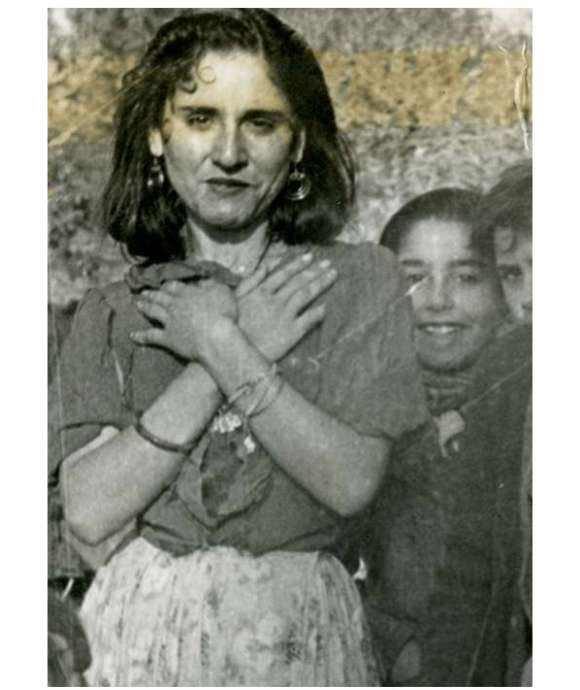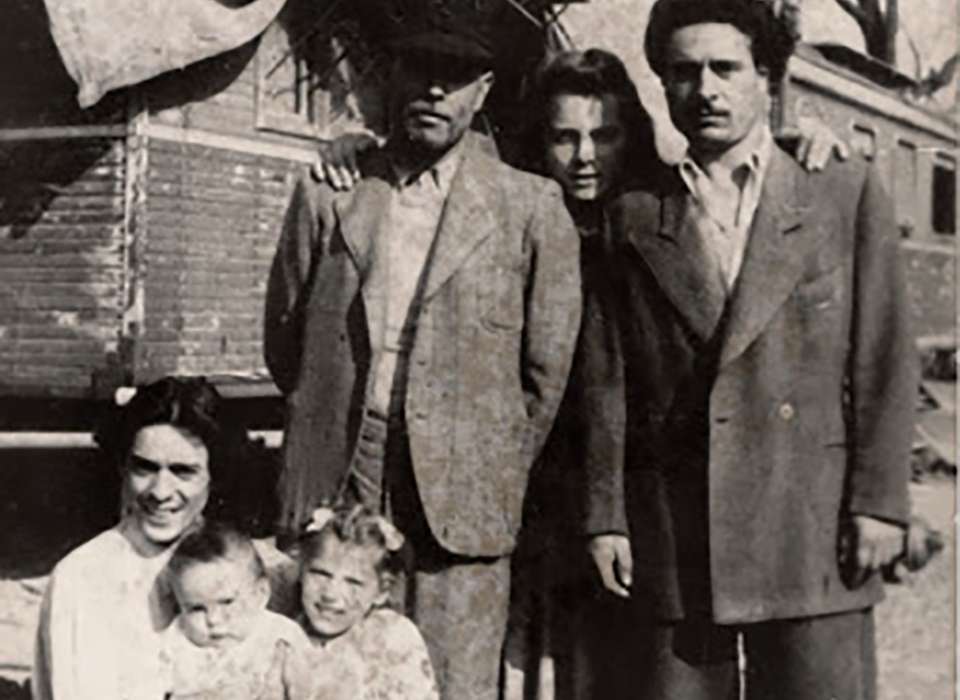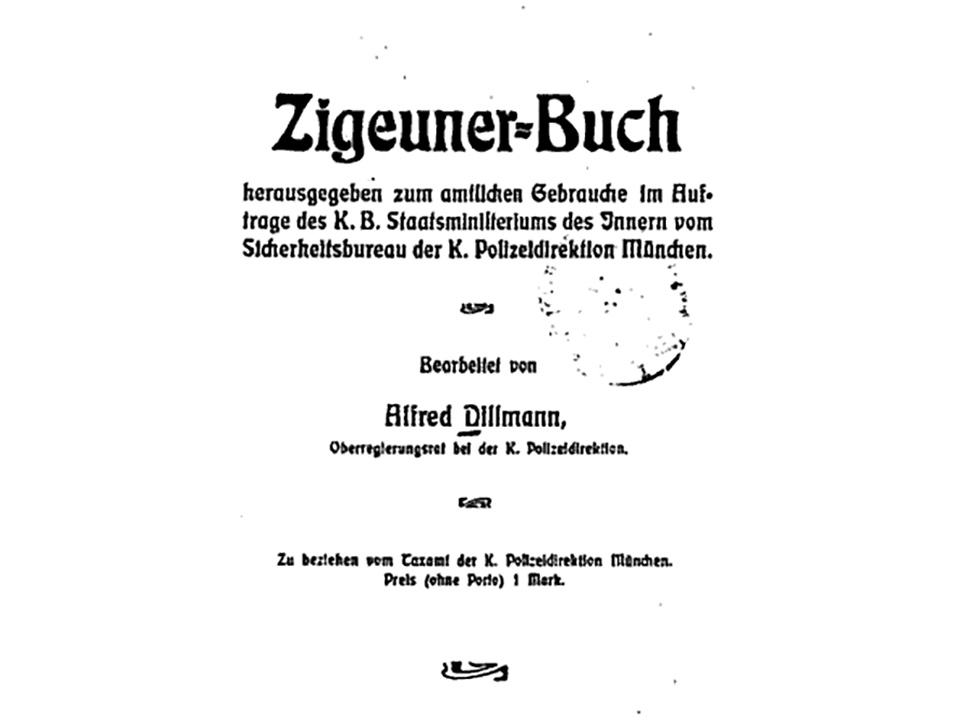Top Image: Romani Family in Germany. Date Unknown. Courtesy of the Holocaust Education and Archive Research Team.
In the first article in this series I approached the issue of anti-Roma racism and the Third Reich via a long prehistory of Roma in Europe until 1900. This was a story of misperception, misrepresentation, and stereotypes. These misrepresentations and stereotypes, I tried to show, possessed a peculiar double character. The Romani culture and lifestyle were both repellent to many Europeans as something alien and corrupt and yet quite fascinating for their seeming non-integration to the world of wage-labor, time-discipline, and the proverbial “rat-race.” During the closing decades of the nineteenth century, the emergence of race theory posed a fundamental challenge, however, to European Roma (in addition to many other groups). Governments in Central Europe attempted to define “Gypsies” as a “race,” as a group defined by shared biological characteristics.
Now I want to push this story forward to the beginning of the Nazi period by examining the shift to regulation and persecution of Roma as a minority within Central Europe. Here the focus is on how anti-Roma sentiment fused with notions of race and with relatively new methods of state surveillance and policing. My example here is what I am calling “the Bavarian precedent.”
During the 1880s and 1890s, Imperial Germany, newly unified under the conservative Chancellor Otto von Bismarck, saw the growth of enormous resentment against Roma. Those Romani men and women who had lived in Germany for generations, known as Sinti, had experienced more than their fair share of hostility. Yet they were not the principal targets.
In what will sound like a very familiar story to an early twenty-first century audience, it was immigration that generated this backlash. Many Romani families left Hungary and Romania and relocated to Germany because of the country’s prosperity. Speaking a variant of the Romani language indebted to Romanian and often more darker-skinned, these newcomers suffered a ferocious response from authorities.
Among the German states, the Kingdom of Bavaria proved the most zealous in its anti-Roma measures. In 1885, the Bavarian government passed a law tightening the distribution of licenses to Romani traders. This legislation targeted the itinerant, i.e. those who moved from community to community, and made it easier to revoke licenses already granted. Moreover, the 1885 law swept up undocumented Roma. Once non-citizens were incarcerated, they were forced to pay for all legal costs up to and including expulsion from the Kingdom.
Although Roma adjusted to the new, harsh reality and more and more of them began to shift away from the traditional ways of travel and settled into communities in southern Germany, social and political anxiety about their presence did not abate. A truly frightening step was taken in Bavaria in 1899, when security police in Munich created a “Central Office for Gypsy Affairs.” The director, Alfred Dillmann, established a disquieting precedent for surveillance and information-gathering. According to Guenter Lewy, he instructed local police to compile reports on Roma, detailing “the nature of the identity papers they carried, how many animals, especially horses, the itinerants had, from where they had come and in which direction they had moved, and whether the police had taken any measures against them.”
It did not stop there. Prosecutors were pushed to inform the Central Office about any lawbreaking by Romani men and women, and copies of documents pertaining to births, marriages, and deaths had to be rendered. Dillmann took great pride in the volume, Zigeuner-Buch (Gypsy Book), his office produced in 1905. The edition of 7,000 copies offered a compendium of laws and rules applicable to Roma and listed the names of thousands of them and what they had been apprehended for by police. Criminalization of a whole host of activities ranging from setting up camp, to building fires and grazing their animals was promoted in the book. Many other German states followed suit.
Title page of the Zigeuner-Buch (Gypsy Book) issued by the Munich police. Alfred Dillmann’s name is prominently displayed. Credit: The Bayerische Staatsbibliothek, Munich. Courtesy of Wikimedia Commons.
Eventually, the net of surveillance would widen still further. In 1911, police undertook the fingerprinting of all Roma in Bavaria. The fingerprints and information amassed from public registry offices were inserted into these files. A huge body of personal data accumulated, providing both information and a model for future waves of persecution.
Officials in Bavaria bemoaned, though, the absence of a national policy on Roma. A December 1911 meeting, organized by the Ministry of the Interior, brought to Munich representatives from Prussia, Baden, Württemberg, Hesse, Saxony, and Alsace-Lorraine. At first, disagreement over how to categorize a “Gypsy” ensued. Then some consensus resulted, certifying that both the discovery of the continued practice of the nomadic lifestyle, as well as racialized definitions of the Zigeuner, were valid. In other words, Roma were condemned for what they did and for being a largely unassimilable “race.”
Bavaria’s role in pioneering a new and insidious form of governmental persecution of Roma did not end with World War I and the German Revolution of 1918-19, which toppled the Kingdom’s Wittelsbach Dynasty. Now a part of the new Weimar Republic, it became a hotbed of right-wing extremism, not least of which was Adolf Hitler’s National Socialist German Workers’ (or Nazi) Party. Hitler, it must be remembered, tried to seize power in Munich in November 1923, in the failed Beer Hall Putsch.
Although the Putsch was put down, reactionary elements still dominated policymaking in Bavarian politics. Once more, Roma found themselves on the receiving end of legislative assaults. In July 1926, the Law for the Combating of Gypsies, Travelers, and the Work-Shy was enacted. Social Democrats and Communists in the legislature failed to prevent its passage. The Bavarian Ministry of the Interior again seeded this renewed persecution by calling for action against itinerants, dubbed “travelers” in the law’s title.
What exactly did this law entail? It specified that “Gypsies and persons who roam about in the manner of Gypsies—‘travelers’—may only itinerate with wagons and caravans if they have permission from the police authorities responsible.” Such permission, if granted, could only extend to a calendar year but could be revoked at any point. Furthermore, Roma were not permitted to move from site to site with children who were of school age. Only the police could make exceptions. The law also limited where “Gypsies and travelers” might make encampments and park their wagons or caravans. Banned from having firearms and only allowed to “itinerate with horses, dogs, and animals which serve commercial functions if they possess a license,” wandering Roma could not form “bands.” Essentially, their movement was limited to very small groups or individual families. Perhaps the most draconian aspect of the legislation was that any Roma over “sixteen years of age who are unable to prove regular employment may be sent to workhouses for up to two years by the responsible police authorities on the grounds of public security.” As Michael Burleigh and Wolfgang Wippermann (whose translation of the articles of the 1926 Law I utilize) point out, this law remained in effect until American occupation authorities overturned it in July 1947.
Over four decades then, authorities in Bavaria devised an entire system for identifying, documenting, regulating, and intervening in the lives of the Romani people. Immigration was the trigger, yet the vicious response went far beyond creating quotas and denying entry. Officials in the Ministry of the Interior, police, and political elites erected a legal framework devoted almost exclusively to their panic over the “Gypsy question.” Buttressed by notions about race and criminality, this framework facilitated coordination between security forces across Germany. The mounds of personal information collected in those 40 years was a gigantic resource to any future agency.
Thus, when Hitler and the Nazis took power in Germany in 1933, they did not have to forge a new policy for Roma. Instead, they tapped a vast array of experience, documentation, and legislation. What they did with “the Bavarian precedent” is the subject of the next article in this series.

Fascination and Hatred: The Roma in European Culture
There is insufficient attention paid to the long history of the Roma within European culture.
Jason Dawsey, PhD
Jason Dawsey, PhD, is ASU WWII Studies Consultant in the Jenny Craig Institute for the Study of War and Democracy.
Cite this article:
MLA Citation:
APA Citation:
Chicago Style Citation:







![Max Fuchs, New York City cantor, sings as Rabbi Sydney [sic] Lefkowitz, Richmond, VA, conducts the first Jewish services from Germany.](/sites/default/files/styles/max_650x650/public/2025-10/image1.jpg)


